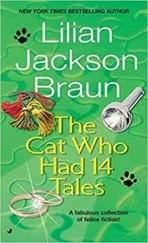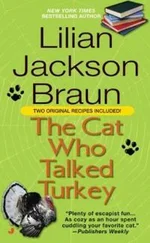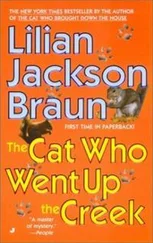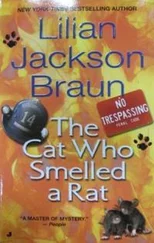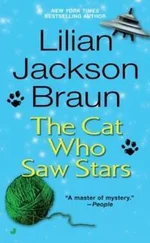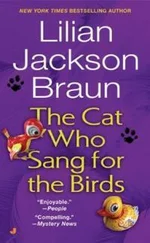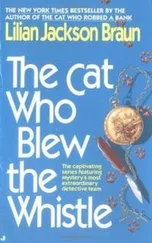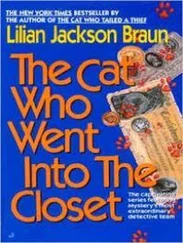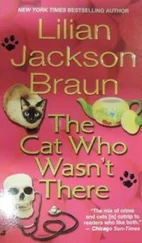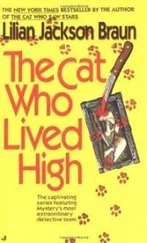Лилиан Браун - The Cat Who Had 60 Whiskers
Здесь есть возможность читать онлайн «Лилиан Браун - The Cat Who Had 60 Whiskers» весь текст электронной книги совершенно бесплатно (целиком полную версию без сокращений). В некоторых случаях можно слушать аудио, скачать через торрент в формате fb2 и присутствует краткое содержание. Год выпуска: 2010, Жанр: Детектив, на английском языке. Описание произведения, (предисловие) а так же отзывы посетителей доступны на портале библиотеки ЛибКат.
- Название:The Cat Who Had 60 Whiskers
- Автор:
- Жанр:
- Год:2010
- ISBN:нет данных
- Рейтинг книги:5 / 5. Голосов: 1
-
Избранное:Добавить в избранное
- Отзывы:
-
Ваша оценка:
- 100
- 1
- 2
- 3
- 4
- 5
The Cat Who Had 60 Whiskers: краткое содержание, описание и аннотация
Предлагаем к чтению аннотацию, описание, краткое содержание или предисловие (зависит от того, что написал сам автор книги «The Cat Who Had 60 Whiskers»). Если вы не нашли необходимую информацию о книге — напишите в комментариях, мы постараемся отыскать её.
the popular series finds Moose
County in an uproar over a
string of lucrative inheritances
and a bee sting-related death,
throughout which Polly departs for Paris, Koko the irrepressible
Siamese meets a piano tuner,
and Qwill writes a play.
The Cat Who Had 60 Whiskers — читать онлайн бесплатно полную книгу (весь текст) целиком
Ниже представлен текст книги, разбитый по страницам. Система сохранения места последней прочитанной страницы, позволяет с удобством читать онлайн бесплатно книгу «The Cat Who Had 60 Whiskers», без необходимости каждый раз заново искать на чём Вы остановились. Поставьте закладку, и сможете в любой момент перейти на страницу, на которой закончили чтение.
Интервал:
Закладка:
They went indoors and the guest gasped over the vast spaces, ramps winding around the interior, the views from the balcony levels—all the while followed by the Siamese like hired security guards.
“They like you!” the host said. “Do you have cats?”
“We have one of Moira’s friendly marmalades at the library—the staff named him Reggie—and I have a bossy Siamese at home, called Caesar.”
“How do you two strong-minded individuals get along?”
“Oh, I let him have his way…and he lets me have mine.”
While waiting for lunch to be delivered by the caterer, they had aperitifs in the gazebo. On the way she saw the British Silverlight in the foyer. She asked, “Do you do cross-country biking?”
“No. Do you?”
“Not since my college days. Memorable times! Especially in the British Isles.”
She raved over the gazebo, screened on eight sides. Vivian had heard about Squunk water and wanted to try it. He recommended a drink he had created called “Moose County Madness” that consisted of Squunk water and cranberry juice.
Qwilleran said, “I’d like to put something to you, Vivian. There appears to be a big difference between Lockmaster County and Pickax. Would it be appropriate—or even desirable—for the two counties to close the gap with a show of art hats at each venue?”
Qwilleran went on: “Once upon a time…I’m going to sound like a storyteller…there was a Moose County potato farmer named Milo Thackeray, who reared motherless twins, Thurston and Thelma. She was a little taller, stronger, bolder than her brother and always looked after him. They were quite different.
“Thurston went to veterinary college in the east, married another doctor, came home, and started an animal hospital in Lockmaster. They had one son. The more flamboyant Thelma went to California and had a successful career with a private dinner club—never married, but kept a protective eye on her younger brother. His son was a problem.
“Eventually, she retired and came back to Moose County to help, if possible, with her difficult nephew. She brought her rare collection of twenty-five art hats, which were to be the subject of a book and a traveling exhibit…. All the plans were ruined by the nephew, who destroyed not only the family and himself but the collection of art hats. The family scandal left a stain on the good name of Thackeray. Even the hospital changed its name under a new owner.”
Qwilleran paused for her reaction.
“How very sad,” she murmured.
“But that isn’t the end of the tale…. The twenty-five hats were photographed before they were destroyed, and I can show you the prints!”
Then lunch was served, and they turned to the subject of Thelma Thackeray’s dinner club. How as hostess Thelma had always worn a hat as she moved through the dining room, chatting with members…and how Thelma had always stolen the show with her exotic headgear at Pickax restaurants like the Old Grist Mill, and the Mackintosh Inn.
Qwilleran said, “What I want to discuss with you is the size of the show. Someone once said that the more art you look at, the less you see. What I propose is two small exhibitions opening simultaneously at the Lockmaster Library and the Pickax gallery. At the end of a certain length of time, the two shows would be reversed, and showgoers would have yet another thrill.”
“You’re absolutely right!” she said. “Our exhibit case will accommodate a dozen photos without crowding, and I imagine that’s true of the one in Pickax.”
After lunch the tables were cleared and the photos of the Thackeray art hats were viewed and lavished with praise and amazement.
Vivian said, “The hats are much more dramatic than the ones we design here in the boondocks! Who was the photographer?”
“John Bushland. Had a studio in the Inglehart house before it was a restaurant. Now he’s on the staff of theMoose County Something. I helped him take the shots, acting as photographer’s flunky. For the exhibits he’ll print them on matte stock and mount them on matte board with easel backs.”
“What information will be available for the identification cards?”
“Name of hat, artist, and date.”
“I’m weak with excitement!” she said. “And to think that it happened on Marconi Trail!”
“One question,” he said. “Thelma not only wore lizard-skin shoes, she kept her hats in lizard-print hatboxes, destroyed along with the hats….”
“That’s part of the hat hobby. We make our own signature hatboxes. Mine are gray pinstripe. If we could find some lizard-print paper, we could make one of Thelma’s signature boxes for each exhibit, as an accent.”
Qwilleran was enthusiastic; she was getting into the spirit. He said, “If you need any help along the way, Pickax has a new coordinator of community activities. She has ideas and enthusiasm—Daisy Babcock. You are on the same wavelength. I’ll have her phone you.”
Later, they returned to the barn interior.
“You don’t have a piano,” she remarked, as if noting the absence of indoor plumbing.
“No. My mother was an excellent pianist and wanted to give me lessons, but I preferred sandlot baseball. The barn has a fantastic music system and brilliant acoustics. Lately I’ve acquired some CDs of the Ledfields playing violin and piano, which I’d like you to hear.”
“I wonder how a grand piano would sound in this environment? Frankie, the piano tuner, gives concerts, you know.” Hearing no reaction, she went on, “My parents are retiring to Florida and liquidating their furnishings, including a Steingraeber & Söhn grand piano made in Bavaria. Perhaps you’d like to take it on trial. There are several spaces that would be suitable—”
“Hold on! Do you realize this barn is in deep freeze five months of the year? But I’m sure the K Fund would buy it for the forthcoming music center. They could have concerts called the Hartman Series featuring talent from both counties!”
That night Qwilleran wrote in his private journal:
There are times when I wish I had taken those piano lessons! I would have left the high-speed stuff to Joe and concentrated on numbers with crashing chords that would frighten the cats and knock the pictures off the walls.
For the next two weeks Qwilleran was busier than he’d ever been. When Mildred Riker asked, “Have you heard from Polly?” he replied, “Polly who?”
There were postcards from Paris, of course, but life in Pickax was challenging in many directions. The Library Hat Show alone had enlisted his attention in several ways: lining up Daisy Babcock, working with Bushy on prints, finding some lizard-print paper to cover a couple of hatboxes…and, yes, lining up G. Allen Barter for the K Fund donation of a Steingraeber grand piano to the music center, not to mention finding Frankie a new page turner and driver, giving a talk to the Senior Health Club on private journals, writing a play titledThe Cat Who Got Elected Dogcatcher. His Qwill Pen column had to come from the “trash barrel,” meaning bits and pieces of this and that that could appear fascinating to his readers. He hardly had time to feed the cats, let alone read to them from theWilson Quarterly.
Meanwhile, those stunning green postcards from Paris were arriving all over town, and recipients were talking about the beautiful river, all those bridges, the Eiffel Tower and the Arc de Triomphe, and especially the stray cats in the cemetery.
People said, “How come we don’t have stray cats in the cemetery?”…It was seen as a cultural deficiency, so citizens proposed a committee to promote it. Qwilleran tactfully declined their invitation to champion their cause with Koko as mascot.
THIRTEEN
Late Thursday afternoon, when Vivian had returned to Lockmaster and her precocious Caesar, Qwilleran felt the satisfaction of a job well done: the launching of a two-county effort and the discovery of yet another librarian with intelligence, vocabulary…and cats.
Читать дальшеИнтервал:
Закладка:
Похожие книги на «The Cat Who Had 60 Whiskers»
Представляем Вашему вниманию похожие книги на «The Cat Who Had 60 Whiskers» списком для выбора. Мы отобрали схожую по названию и смыслу литературу в надежде предоставить читателям больше вариантов отыскать новые, интересные, ещё непрочитанные произведения.
Обсуждение, отзывы о книге «The Cat Who Had 60 Whiskers» и просто собственные мнения читателей. Оставьте ваши комментарии, напишите, что Вы думаете о произведении, его смысле или главных героях. Укажите что конкретно понравилось, а что нет, и почему Вы так считаете.

